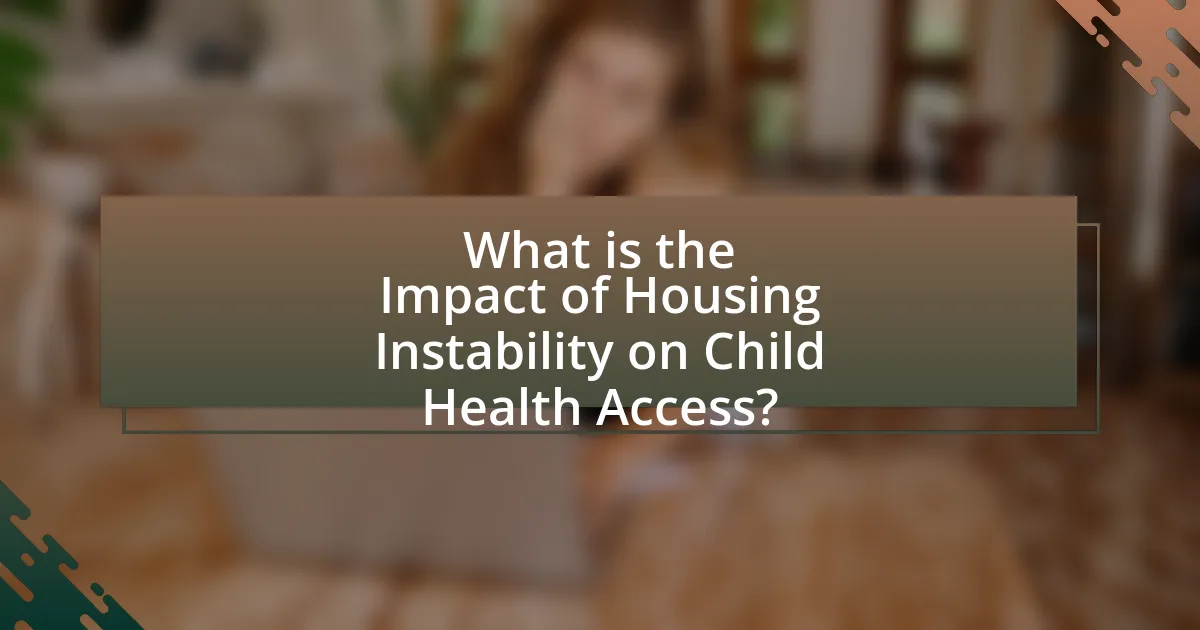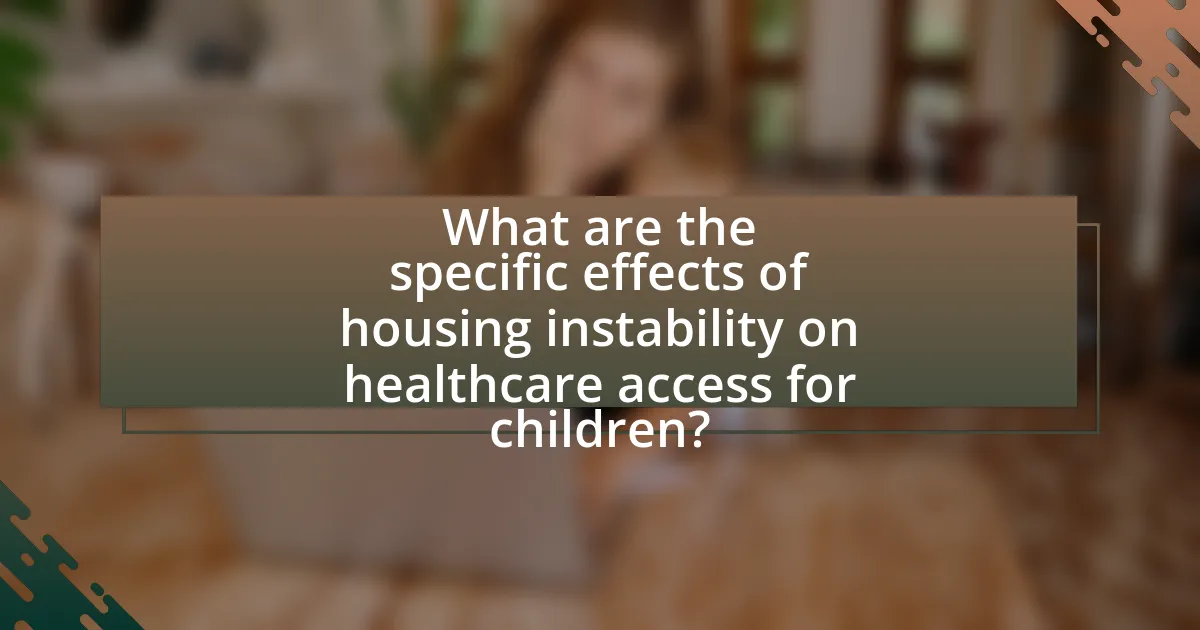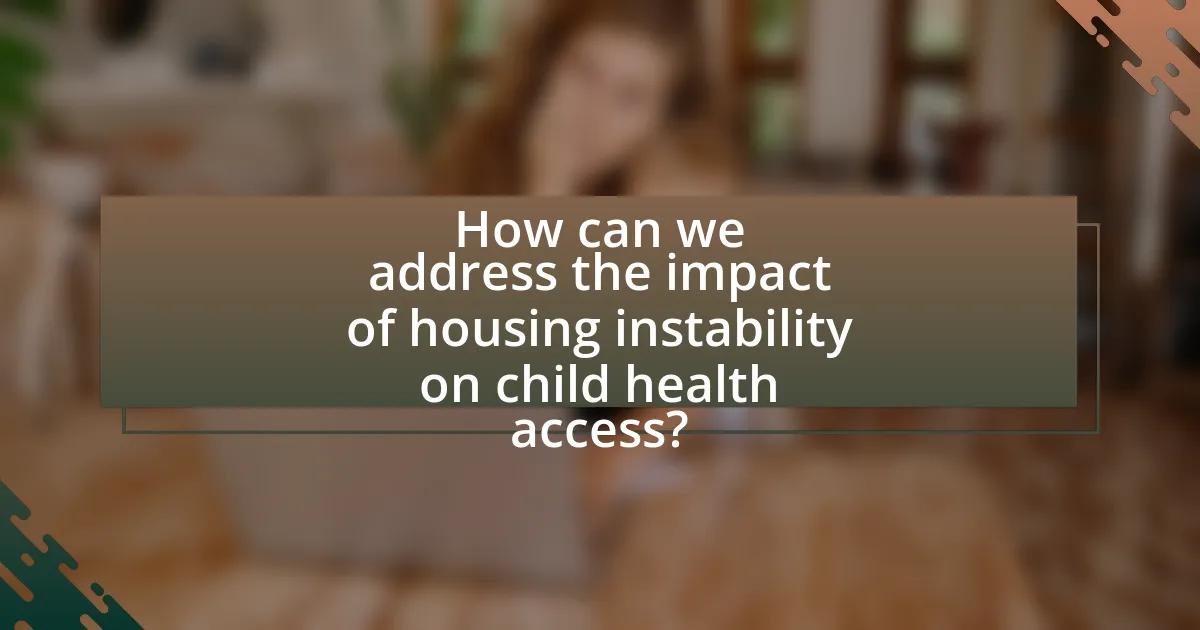Housing instability significantly impacts child health access by creating barriers to consistent healthcare services, leading to missed appointments and inadequate preventive care. Children in unstable housing situations are more likely to experience unmet medical needs, chronic conditions, and mental health issues due to increased stress and environmental hazards. The article explores the correlation between housing instability and health outcomes, highlighting the socioeconomic factors that exacerbate these challenges. It also discusses the long-term implications of housing instability on children’s health and suggests strategies for improving healthcare access through community programs and policy interventions.

What is the Impact of Housing Instability on Child Health Access?
Housing instability significantly impairs child health access by creating barriers to consistent healthcare services. Children experiencing housing instability often face disruptions in their healthcare continuity, leading to missed appointments and inadequate preventive care. Research indicates that families with unstable housing are more likely to report unmet medical needs, with studies showing that 25% of children in unstable housing situations do not receive necessary medical care. This lack of access can result in worsening health outcomes, including increased rates of chronic conditions and mental health issues among affected children.
How does housing instability affect children’s overall health?
Housing instability negatively impacts children’s overall health by increasing their risk of physical and mental health issues. Children experiencing housing instability often face higher rates of chronic conditions such as asthma and obesity, as well as mental health challenges like anxiety and depression. Research indicates that unstable housing can lead to increased stress and trauma, which adversely affects children’s development and well-being. For instance, a study published in the journal “Pediatrics” found that children in unstable housing situations are more likely to experience frequent hospitalizations and have lower overall health outcomes compared to their peers in stable homes.
What are the physical health consequences of housing instability for children?
Housing instability negatively impacts children’s physical health by increasing their risk of chronic conditions, respiratory issues, and developmental delays. Children experiencing housing instability often face higher exposure to environmental hazards, such as mold and lead, which can lead to asthma and other respiratory problems. Additionally, the stress associated with unstable housing can weaken immune systems, making children more susceptible to infections. Research indicates that children in unstable housing situations are more likely to experience obesity and related health issues due to limited access to nutritious food and safe spaces for physical activity. These health consequences are supported by studies showing that housing instability correlates with poorer overall health outcomes in children.
How does housing instability influence mental health in children?
Housing instability negatively influences mental health in children by increasing stress, anxiety, and behavioral issues. Research indicates that children experiencing frequent moves or homelessness face higher rates of depression and anxiety disorders compared to their peers with stable housing. A study published in the Journal of Child Psychology and Psychiatry found that children who are homeless or frequently displaced are more likely to exhibit emotional and behavioral problems, with 30% of these children showing significant mental health issues. This correlation highlights the detrimental effects of unstable living conditions on children’s psychological well-being.
Why is child health access critical in the context of housing instability?
Child health access is critical in the context of housing instability because unstable housing directly affects children’s physical and mental health outcomes. Research indicates that children experiencing housing instability are more likely to face health issues such as asthma, developmental delays, and mental health disorders. For instance, a study published in the American Journal of Public Health found that children in unstable housing situations are 50% more likely to have unmet health care needs compared to their peers in stable homes. This lack of access to health care exacerbates existing health problems and hinders preventive care, leading to long-term negative health consequences.
What barriers do children face in accessing healthcare due to housing instability?
Children face significant barriers in accessing healthcare due to housing instability, primarily including lack of stable transportation, inconsistent healthcare coverage, and increased stress and trauma. Lack of stable transportation limits children’s ability to attend medical appointments, while inconsistent healthcare coverage often results from frequent moves, leading to gaps in insurance and access to care. Additionally, the stress and trauma associated with housing instability can negatively impact children’s physical and mental health, making them less likely to seek necessary medical attention. Studies indicate that children experiencing housing instability are more likely to have unmet healthcare needs, further exacerbating health disparities.
How does housing instability affect preventive care and health outcomes?
Housing instability negatively impacts preventive care and health outcomes by creating barriers to accessing healthcare services. Individuals experiencing housing instability often face increased stress, which can lead to mental health issues and chronic conditions, ultimately reducing their likelihood of seeking preventive care. Research indicates that children in unstable housing situations are less likely to receive vaccinations and regular check-ups, leading to poorer health outcomes. A study published in the American Journal of Public Health found that families with unstable housing reported higher rates of unmet medical needs, demonstrating a direct correlation between housing instability and decreased access to preventive health services.

What are the specific effects of housing instability on healthcare access for children?
Housing instability significantly impairs healthcare access for children by creating barriers to consistent medical care. Children experiencing housing instability often face disruptions in their healthcare continuity, leading to missed appointments and inadequate follow-up care. Research indicates that families in unstable housing situations are less likely to have health insurance, which further limits access to necessary services. For instance, a study published in the Journal of Pediatrics found that children from unstable housing backgrounds are 1.5 times more likely to experience unmet healthcare needs compared to their peers in stable homes. Additionally, the stress associated with housing instability can exacerbate health issues, making it more challenging for children to receive timely medical attention.
How do socioeconomic factors relate to housing instability and child health access?
Socioeconomic factors significantly influence housing instability and child health access. Families with lower income often face challenges in securing stable housing, leading to frequent relocations or homelessness, which disrupts children’s access to consistent healthcare services. Research indicates that children in unstable housing situations are more likely to experience health issues, including asthma and developmental delays, due to environmental stressors and lack of regular medical care. For instance, a study published in the American Journal of Public Health found that children living in unstable housing are 1.5 times more likely to have unmet health needs compared to their peers in stable environments. This correlation underscores the critical role that socioeconomic status plays in determining both housing stability and the accessibility of healthcare for children.
What role does family income play in healthcare access for children facing housing instability?
Family income significantly influences healthcare access for children experiencing housing instability. Higher family income typically correlates with better access to healthcare services, as families with more financial resources can afford insurance, transportation, and out-of-pocket medical expenses. Conversely, families with lower income often face barriers such as lack of insurance, inability to pay for necessary treatments, and limited access to healthcare facilities, which can exacerbate health issues in children. Research indicates that children from low-income families are more likely to experience unmet healthcare needs, leading to poorer health outcomes. For instance, a study published in the Journal of Pediatrics found that children in families with incomes below the federal poverty level were less likely to receive timely medical care compared to their higher-income counterparts.
How does parental education impact child health access in unstable housing situations?
Parental education significantly influences child health access in unstable housing situations by affecting parents’ ability to navigate healthcare systems and advocate for their children’s needs. Educated parents are more likely to understand health information, utilize available resources, and seek preventive care, which is crucial in unstable housing contexts where access to consistent healthcare can be limited. Research indicates that children from families with higher parental education levels are more likely to have regular medical check-ups and receive vaccinations, as educated parents are better equipped to prioritize and manage their children’s health needs despite housing instability.
What are the long-term implications of housing instability on child health access?
Housing instability significantly impairs child health access over the long term. Children experiencing housing instability often face barriers to consistent healthcare, leading to unmet medical needs and poorer health outcomes. Research indicates that unstable housing correlates with increased rates of chronic conditions, such as asthma and obesity, due to environmental stressors and lack of access to preventive care. Furthermore, studies show that children in unstable housing situations are less likely to have a regular healthcare provider, which is crucial for ongoing health management and early intervention. This lack of continuity in care can result in delayed diagnoses and treatment, exacerbating health issues and increasing healthcare costs in the long run.
How does housing instability affect children’s health outcomes into adulthood?
Housing instability negatively affects children’s health outcomes into adulthood by increasing the risk of chronic health conditions, mental health issues, and reduced access to healthcare services. Research indicates that children who experience housing instability are more likely to suffer from asthma, obesity, and developmental delays, which can persist into adulthood. A study published in the American Journal of Public Health found that individuals who faced housing instability during childhood had a higher likelihood of experiencing mental health disorders and lower overall health status as adults. This correlation highlights the long-term consequences of unstable housing on physical and mental well-being, emphasizing the importance of stable living conditions for healthy development.
What are the potential societal costs associated with poor child health access due to housing instability?
Poor child health access due to housing instability leads to significant societal costs, including increased healthcare expenditures, diminished educational outcomes, and heightened social service demands. Children facing housing instability often experience chronic health issues, which result in higher medical costs; for instance, families with unstable housing are 1.5 times more likely to incur emergency room visits. Additionally, these children tend to perform poorly in school, leading to long-term economic consequences; research indicates that students from unstable housing backgrounds are 50% more likely to drop out of high school. Furthermore, the strain on social services escalates as communities must allocate more resources to address the needs of these vulnerable populations, ultimately burdening local economies.

How can we address the impact of housing instability on child health access?
To address the impact of housing instability on child health access, implementing comprehensive support systems is essential. These systems should include stable housing initiatives, access to healthcare services, and community resources that specifically target families facing housing insecurity. Research indicates that children in unstable housing situations are more likely to experience health issues, including asthma and developmental delays, due to stress and lack of access to consistent medical care. For instance, a study published in the American Journal of Public Health found that children in unstable housing are 1.5 times more likely to have unmet health needs compared to their peers in stable homes. By providing financial assistance for housing, integrating healthcare services within community organizations, and ensuring that families have access to transportation, we can significantly improve health outcomes for children affected by housing instability.
What strategies can be implemented to improve healthcare access for children in unstable housing?
To improve healthcare access for children in unstable housing, implementing mobile health clinics is essential. Mobile health clinics can reach children in transient living situations, providing essential services such as vaccinations, check-ups, and mental health support directly in their communities. Research indicates that mobile clinics can significantly increase healthcare utilization among underserved populations, with studies showing that they improve access to care by 30% in areas with high housing instability. Additionally, partnerships with local schools and community organizations can facilitate outreach and education, ensuring families are aware of available services and resources.
How can community programs support families facing housing instability?
Community programs can support families facing housing instability by providing essential resources such as emergency housing assistance, financial literacy training, and access to social services. These programs often collaborate with local organizations to offer immediate relief, such as temporary shelter and food assistance, which can stabilize families in crisis. For instance, the National Low Income Housing Coalition reports that housing assistance programs can reduce homelessness by 30%, demonstrating their effectiveness in addressing immediate needs. Additionally, community programs may offer long-term solutions like job training and educational opportunities, which empower families to achieve financial stability and secure permanent housing. By addressing both immediate and systemic issues, community programs play a crucial role in mitigating the effects of housing instability on families.
What role do policymakers play in mitigating the effects of housing instability on child health access?
Policymakers play a crucial role in mitigating the effects of housing instability on child health access by implementing policies that ensure affordable housing, enhance access to healthcare services, and provide support for families facing housing challenges. For instance, initiatives such as the Housing Choice Voucher Program help low-income families secure stable housing, which is linked to improved health outcomes for children. Research indicates that stable housing reduces stress and promotes better access to healthcare, thereby positively impacting child health. Additionally, policymakers can advocate for integrated services that combine housing assistance with healthcare access, further addressing the interconnected issues of housing and health.
What best practices can be adopted to enhance child health access amidst housing instability?
To enhance child health access amidst housing instability, implementing mobile health clinics is a best practice. Mobile health clinics provide accessible healthcare services directly to underserved communities, reducing barriers such as transportation and cost. Research indicates that mobile clinics can improve health outcomes by offering preventive care, vaccinations, and health education in areas with high housing instability, as demonstrated by a study published in the Journal of Community Health, which found that mobile clinics increased access to care by 30% in low-income neighborhoods. Additionally, integrating social services with healthcare can address the multifaceted needs of families facing housing instability, ensuring that children receive comprehensive support for both health and housing challenges.
How can healthcare providers better serve children from unstable housing backgrounds?
Healthcare providers can better serve children from unstable housing backgrounds by implementing integrated care models that address both health and social needs. These models facilitate access to comprehensive services, including mental health support, nutrition assistance, and housing resources, which are crucial for children facing instability. Research indicates that children in unstable housing are at higher risk for health issues, with studies showing that 25% of homeless children experience chronic health conditions, highlighting the need for targeted interventions. By collaborating with community organizations and utilizing mobile health clinics, healthcare providers can reach these vulnerable populations more effectively, ensuring that children receive timely and appropriate care.
What resources are available for families experiencing housing instability to improve health access?
Families experiencing housing instability can access resources such as community health clinics, food assistance programs, and housing support services to improve health access. Community health clinics often provide free or low-cost medical care, including preventive services, which are crucial for maintaining health. Food assistance programs, like the Supplemental Nutrition Assistance Program (SNAP), help families secure nutritious food, which is essential for overall health. Additionally, housing support services, including emergency housing assistance and transitional housing programs, can stabilize living conditions, thereby facilitating better access to healthcare services. These resources collectively address the barriers that housing instability creates, ensuring families can receive necessary health care and support.
